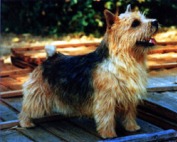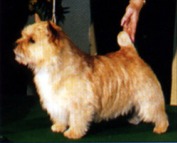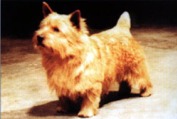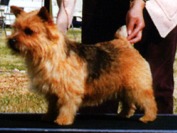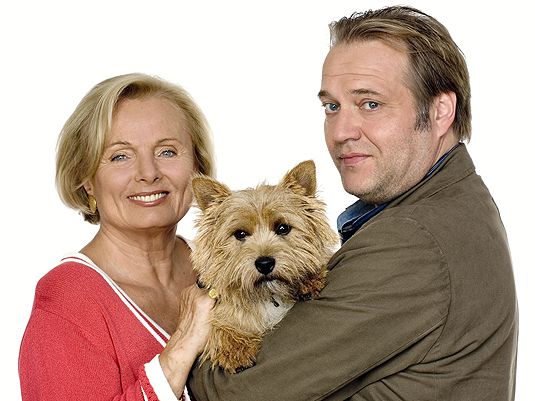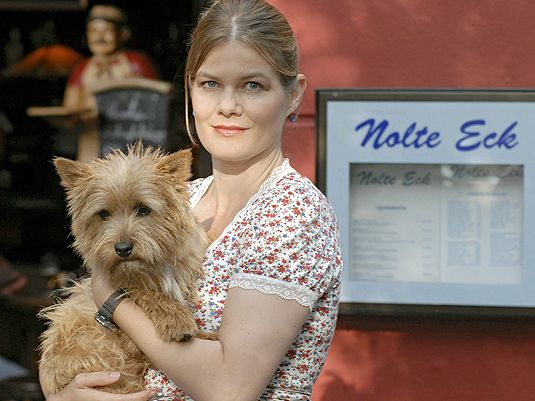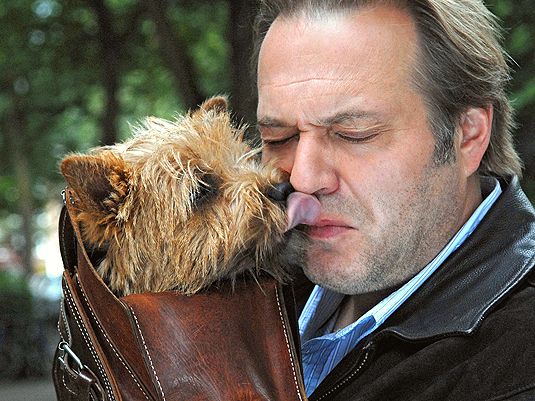
|
ЦВЕТ ШЕРСТИ НОРВИЧ ТЕРЬЕРА. ГЕНЕТИКА ЦВЕТА.В стандарте породы Норвич терьера написано: "Цвет - Все оттенки рыжего, черного с рыжими подпалинами, пшеничного или гризли. Белые участки или отметины нежелательны.»В дни становления породы, рыжий был самым правильным и типичным цветом, но справедливости ради надо отметить, что черно-подпалый тоже был распространен. Действительно, Первым Чемпионом была черная с рыжими подпалинами и стоячими ушами сука "Miss Manette". В течение довольно длительного периода этот цвет не был распространенным и только в 1960-ых постепенно становился достаточно многочисленным.Большинство препотентных производителей 1960-ых- Ch. Whinlatter Charade и его сыновья Ch. Whirilatter Herald and Ch. Interfields Half-a -Bob (непосредственно являющиеся ч/п) производили на свет черно-подпалое потомство. Первый послевоенный чемпион, Ch.Ragus Wheatnor Raven была черной с рыжими подпалинами и влияла через ее сына Ch. Ragus Raven's Wing , и его сына Ch. Ragus Golden Chip, который был ' pinkie'-«розоватый, цвет пинки»- и выдающимся производителем.
Единственной комбинацией, которую еще не упомянули, является скрещивание черно-подпалых с черно-подпалыми, поскольку результат отличен от заявленного Marjorie Bunting в ее статье, которая писала, что родятся "все черные с рыжими подпалинами щенки". Два ч/п сцепляясь вместе не могут произвести классическую рыжину (с возможными редкими исключениями), но могут появиться «пинки». Другой тип рыжих – pinkie, «пинки». У щенков нет никакого пигмента при рождении, и тело сливочного оранжевого или розоватого цвета без темных волос. Родившийся щенок похож на небольшого поросенка, с розовым носом и подушечками лап, которые станут черными через несколько дней. За первые несколько дней пигмент носа и ног развивается. Этот цвет существовал с давнего времени, поскольку мы знаем что Ch. Bigger Banger (внук Ch. Miss Manette), был «пинки», и что он был хорошим препотентным производителем, передавая свой тип потомству. Известный заводчик и селекционер Ch.Bigger Banger и Ch.Miss Manette (и других Норвич терьеров с приставкой "Dickens Character") госпожа Fagan, придумала термин "pinkie". При распространении по всему волосу ЖЕЛТОГО пигмента образуется дикий рыжий (соболиный, муругий) окрас, при котором концы волос могут быть или не быть черными (меланиновые концы) и при котором может быть или не быть маска (напр., ирландский терьер, пшеничник, такса). При рецессивном рыжем окрасе меланин в шерсти не образуется и сохраняется только на коже (выжлы, ирландский сеттер, голден ретривер). ПАЛЕВЫЙ окрас представляет собой ослабленный вариант рыжего (как дикого, так и рецессивного) и может выглядеть совсем белесым (вест-хайленд вайт терьер,шотландстий терьер, лабрадор, голден ретривер). Генетика рыжих типа «pinkie» совершенно другая, не такая как у Истинно рыжих, и вовлеченные гены являются почти наверняка такими же как у палевых желто-сливочных Лабрадоров. Отношения «pinkie» и ч/п более сложные; два «pinkie» сцеплялись вместе могут дать только «pinkie», даже если они несут ч/п ген; чтобы получить другие цвета, один из партнеров должен быть черным с рыжими подпалинами или традиционно рыжим. Ген, который определяет 'розовый' оттенок рыжих, является частью совершенно другого ряда чем те, которые определяют другие цвета. У «pinkie» есть тенденция к более частому появлению белых пятен на груди, и иногда белых звездочек на голове или белых отметин на пальцах ног. Маленькие «pinkie» растут, и цвет их шерсти имеет тенденцию темнеть и может быть неотличимым от нормальной рыжины, хотя никаких темных волос на теле не может быть найдено. Они могут потемнеть до темно-оранжевого цвета, но некоторые остаются весьма светлыми, как бледные сливки. Эти различия происходят, вероятно, из-за взаимодействия с другими генами цвета, растворяющего природный. Традиционная или классическая рыжина тоже может иметь много различных оттенков - от бледно сливочного и пшеничного до темного красно - коричневого цвета и седины-гризли. Пшеничные, у которых часто есть сильные зачернения на мордах и ушах, имеют тенденцию быть более серебристыми, чем «pinkie» и весьма редки сегодня. Есть также и другой тип бледной рыжины, называемый красным/пшеничным (red/wheaten), который у взрослого Норвича неразличим от «pinkie». Главное различие - присутствие темного пигмента и черного остевого длинного волоса при рождении, так же как и нескольких темных волос среди рыжих в течение жизни. Классические рыжие не темнеют с каждой новой шерстью, как это делают «pinkie» идя к апельсиновому цвету пальто. Эти оттенки происходят вероятно из-за другого гена, изменяющего истинный рыжий цвет. Противоположным к светлому пшеничному, является цвет гризли или седина, которая образуется из смеси рыжих и темных волос по всей поверхности тела. Щенки рождаются с нормальным черным плащем-оверлеем волос, но когда их удаляют в шесть недель, в рыжей шерсти все еще есть много темных волос. У всех собак настоящего рыжего цвета в шерсти есть несколько примешанных темных волос, у одних больше чем у других. И у «pinkie» иногда бывает черный подшерсток, который исчезает, когда остевая шерсть выщипана. Самым обычным оттенком рыжих является песочный цвет с более бледным рыжим подшерстком. Очень темный красный «ирландский Сеттер» очень редко замечается у Норвича, чащу у Норфолка. ЧЕРНЫЙ С РЫЖИМИ ПОДПАЛИНАМИ ЦВЕТ. Возвращаясь к черно-подпалым, есть два главных типа – те собаки, которые сохраняют черный чепрак всю жизнь (весьма редкие!); и те, которые постепенно теряют черный цвет и с возрастом становятся рыжими с большим количеством седины, а некоторые и окончательно рыжими. Черное седло сжимается с течением времени, становится ремнем безопасности по плечам, но они всегда сохраняют черный подшерсток, и когда выщипаны, они становятся черным с рыжими подпалинами еще раз (по крайней мере временно!).
Черно-подпалые рождаются черными как уголь с коричневыми точками на морде, пальцах ног и под хвостом. Некоторые новорожденные рыжие щенки были приняты за ч/п из-за черного покрывала волос, но когда они рядом они очень различаются. Если провести рукой против шерсти и раздвинуть ее, ч/п черные к корням (при рождении), тогда как у рыжих есть у корней цвет подпала.. Оттенок подпала бывает от бледных сливок до глубокой каштановой красноты - последний имеет тенденцию (но не всегда) быть у тех собак, которые сохраняют черное седло всю жизнь. У щенков черные области регрессов на ногах и голове весьма быстро становятся коричневыми, в тон подпала. Черные пятна обычно остаются перед каждым ухом, и истинный ч/п сохраняет черный пик на голове и черные плечи и бедра. «Истинный» черно-подпалый генетически ближе к рыжему, а исчезающий ч/п вероятно несет гены «pinkie», которые действуют как фактор растворения цвета. ГЕНЕТИКА Еще раз посмотрим, что можно ожидать от различных спариваний, но с поправками, принимая во внимание «pinkie» и попытаемся объяснить генетику этого:
Обычные классические цвета являются доминирующими - рыжий или с сединой, а черный с рыжими подпалинами встречается намного реже, хотя и является вариантом того же самого генетического ряда. Посмотрим на знаменитых племенных собак и сравним их цвет и цвет щенков из их многочисленных пометов с генетически разными партнерами:
Таким образом за последние годы «pinkie» и изменяющийся ч/п стали более многочисленными, в то время как гризли и истинный черный более редкими. Без сомнения, это происходит из-за влияния различных доминирующих племенных собак!
И в заключении, хотя кажется что порода весьма ограничена в цветах, в действительности есть настоящее разнообразие, и это - очень интересное решение возможностей генетики. Есть три главные цветовые группы: 1. Рыжие - (включают гризли и пшеничников) 2. «Pinkie»- обычно зарегистрированные как 'рыжие пшеничники' или палевые, чтобы избежать беспорядка с пшеничниками (хотя бледную истинную рыжину также можно назвать рыжим пшеничником), 3. Черные с подпалом ( включает исчезающего 'истинного' ч/п с черным чепраком на всю жизнь, и изменяющего цвет на седину). Еще более усложняет дело тот факт, что появились собаки 'blue and tans'- 'синие с подпалом (из-за другого гена, действующего на черный цвет). Щенки появляются серо-синими, и становятся бледными исчезающими ч/п. Все эти цвета соответствуют стандарту, который ясно заявляет "любой оттенок рыжего или черного с рыжими подпалинами". Белый определенно нежелателен, но маленькое белое пятнышко на груди не главное беспокойство. Давно было замечено, что собаки, имеющие повышенную интенсивность окраса шерсти, радужной оболочки глаз, а также пигментации кожи и слизистых оболочек, обладают лучшей нервной системой и более уравновешенной психикой. Этот вывод был сделан давно на основе практического опыта. Сегодня он находит свое подтверждение по результатам научных исследований, объясняющих простую причину высокой степени корреляции между мерой насыщенности пигмента собаки и свойствами ее характера. Эта порода определенно не оценивается на основе одного только цвета, поскольку есть слишком много других намного более важных пунктов стандарта, которые считаются более важными. NORWICH TERRIER COAT COLOUR The Norwih terrier breed standard states: "Colour - All shades of red, black and tan, wheaten or grizzle. White patches or marks are undesirable. In the early days of the development of the breed red was considered to be the correct and most typical colour, and yet the black backed Norwich was fairly common; indeed the first prick eared champion "Miss Manette" was black and tan. For a fairly long period the colour was not as common and it was not until the 1960's that it gradually became numerous enough not to cause comment. The most prepotent sires of the 1960's -Ch. Whinlatter Charade and his sons Ch. Whirilatter Herald and Ch. Interfields Half-a -Bob (himself being b/t) all sired black and tans. The firsf post war champion, Ragus Wheatnor Raven was a black and tan and an influential brood through her son Ch. Ragus Raven's Wing, and his son Ch. Ragus Golden Chip who was a 'pinkie' and an outstanding sire. In the 1964 NTC Handbook Marjorie Bunting wrote a very interesting article on black and tans. She explained the apparent recessiveness of the gene for the b/t coat colour and gave a list of matings of different colour combinations; and expected results. That Handbook was published in the year that my mother and I started showing Norwich terriers and we avidly read all of the information we could find on the breed. At that time it seemed that the b/t gene acted as a simple recessive to the red, but nowadays we realise that the situation is not quite as simple due to the increasing numbers of a different type of red coat colour commonly known as "pinkies".
There are two main types of red colour: - Firstly the traditional Norwich red; the puppies are born with an overlay of black hairs which subsequently are lost and can be plucked out at around 6 weeks old, leaving a clear red body with occasional black hairs mixed in and sometimes a black shading to the muzzle. This type of red is dominant to black and tan i.e. the following table taken from Marjorie Bunting's article will apply: 1 If mating a pure red to a b/t all pups will be red but will carry the b/t gene. 2. If these reds carrying the b/t genes are mated to black and tans there willbe on average an equal number of red and b/t puppies born. 3. Mating together two reds carrying the b/t genes will result on average 1/4 pure red, 1/4 b/t and 1/2 red carrying the b/t genes. 4. Pure reds mated together will only produce pure reds. 5. A pure red mated to a red carrying the b/t genes will produce all red with on average 1/2 carrying the b/t genes. The only combination I have not mentioned is a black and tan mated to a b/t as the result is known to be different to that stated by Marjorie in her article which was "all black and tan puppies". Two black and tans mated together cannot produce the classic red, (with possible rare exceptions) but pinkies can appear. This other type of red is born pinkie. The nioses and footpads have no pigment at birth and the body coat is a creamy orange colour with no black hairs. The pigment of nose and feet develops in the first few days. This colour has existed since the early days as we know that Ch. Bigger Banger (grandson of Ch. Miss Manette) was a pinkie and he was an influential sire, stamping his good breed type on his progeny. It was the breeder of Bigger Banger and Miss Manette (and all of the other famous "Dickens Character" Norwich terriers) Mrs Fagan who coined the term "pinkie". Marjorie Bunting once told me of her shock and worry when what appeared to be a little piglet was born in one of her early litters. Upon speaking to Mrs. Fagan she was reassured that it was just a 'pinkie' and that the pink nose and pads would turn black in a few days, which indeed they did. The genetics of this type of red are totally different and the genes involved are almost certainly the sarne as seen in cream and yellow breeds such as Labradors. The relationship of pinkies to b/t's is more complex in that two "pinkies" mated together can only produce "pinkies" even if they are carrying the b/t gene; to produce a different colour one of the partners needs to be black and tan or a traditional red. The gene that determines the 'pink' shade of red is part of a different series to those that determine the other colours. There is also a tendency for white patches on the chest to be rather more frequent in "pinkies" and occasionally a white blaze on, the head or white toes can occur. As the "pinkies" grow up the coat colour tends to darken and can be indistinguishable from the normal reds although no black hairs will be found. They may finish up a dark orange colour but some stay quite pale cream. These differences are probably due to the interaction of other genes of a colour diluting nature. Traditional or classic reds can of course also be of many different shades from a pale creamy wheaten to dark brick red and grizzle. The wheatens, which quite often have a lot of black on muzzles and ears, tend to be a more silvery colour than the "pinkies" and are quite rare today. There is another type of pale red sometimes called a red/wheaten that in the adult Norwich is indistinguishable from a 'pinkie'. The main differences are the presence of dark pigment and black top coat at birth, as well as a few black hairs amongst the red ones throughout life. Also they do not darken to orange with each coat change as many "pinkies" do. These shades are probably due to another gene modifying the true red colour. The opposite extreme to the wheaten is the grizzle, which is an even mixture of red and black hairs throughout the coat. The pups are born with the normal black overlay of hairs but when these are removed at six weeks the red coat still has a lot of black hairs firmly mixed in. I well remember selling a pup of this colour from one of my early litters assuming it would become red. I advised the new owner to keep on plucking out any black hairs which of course proved to be impossible much to their concern, as the pup had a new coat of red and black hairs mixed together and was actually grizzle. (It was a show puppy sold to a new exhibitor and subsequently became a Champion!). All of the other types of red coat colour have a few black hairs intermingled, some more than others, and sorne even have a black undercoat which disappears when the top coat is stripped. The most usual shade of red is a sandy colour with a paler red undercoat, the very dark 'Irish Setter' red is less often seen in the Norwich than in the Norfolk.
To return to the black and tans, there are two main types - those that keep a black saddle for life (Quite rare); and those that gradually lose the black and become more of a red grizzle the older they become, some ending up virtually indistinguishable from the reds. The black saddle shrinks over the years becoming a harness like pattern over the shoulders, but they always retain a black undercoat and when stripped, they become a black and tan once more (at least temporarily!). Black and tans are born jet black with tan points to the muzzle, toes and under the tail. Some new born red pups have been mistaken for b/t's due to the black overlay of hair, but seen side by side they are quite different. If the body coat is pushed back the b/t's are black to the roots (at birth) whereas the reds have tan coloured roots. The shade of tan is variable from a pale cream to deep chestnut red - the latter tends (but not always) to go with the ones who retain the black saddle. The area of black regresses quite quickly in pups and the legs and head become tan. Black patches usually remain in front of each ear, and true black and tans retain a black peak on the head and black shoulders and thighs. I believe that the 'true' black and tans are genetically closer to the red colour and the fading b/t's probably carry 'pinkie' genes, which act as a dilution factor on the colour.
I would like to quote from Marjorie's original article but with amendments to take into account the "pinkies" and to try to explain the genetics of what one might expect to get from different matings: 1. A dog or bitch, which produces b/t puppies, must carry the gene for b/t. meaning that both parents are responsible. 2. All pups breed from a b/t parent will carry the gene no matter what their own colour. 3. A b/t does not carry the red gene but can carry the "pinkie" gene. 4. To produce a b/t the gene for this colour must be carried by both parents. 5. To produce a 'pinkie', I believe that both parents must carry the gene. 6. All puppies bred from a 'pinkie', no matter what their own colour, will carry the genes. For those of you interested in genetics there is a very good book by Clarence C. Little called "The Inheritance of Coat Colour in Dogs." Although it is rather old (1971), and probably out of date and print, it explains the basic concept and complexities of breeding for colour in dogs. There is a description of each series of genes that is known to influence colour in the various breeds including the Norwich. Of course no mention is made of the "pinkies" although occasional white spots are noted. The usual colours are said to be the dominant red or grizzle, and the then more rare and recessive black and tan, which are all variants of the same genetic series. INFLUENTIAL STUD DOGS Out of interest I have researched into the colours of all the top stud dogs since 1964 (the first year of this award) and have determined the known colours of their progeny:
Thus over the more recent years, pinkies and fading black and tans have become more numerous while grizzles and true black and tans are rarer. This is no doubt due to the influence of different dominant stud dogs and would make an interesting article in itself! To conclude, although our breed seems quite straightforward in its colours, in reality there is quite a variety, and it is very interesting working out the possible genetics. There are I believe three main colour groups. 1. Reds - (to include grizzles and wheatens) 2. Pinkies - usually registered as 'red wheatens' to avoid confusion with wheatens (although the pale true reds can also be called red wheatens ) 3. Black and tans (to include 'true' b/t's staying black for life, and fading b/t's which merge with the grizzles). To further complicate matters just occasionally 'blue and tans' have appeared, due to another diluting gene acting on the black colour. These start off grey-blue as pups, and end up as pale fading b/t's. I believe that these colours fit the standard, which clearly states "any shade of red or black and tan". White is definitely undesirable but as long as it does not predominate in any way and remains as a patch on the chest 1 do not think that it is a major worry. This breed should definitely not be judged on the basis of colour alone as there are too many other much more important points to be considered first. Ruth E. Corkhill The Norwich Terrier Club 2000 Handbook
http://www.daserste.de/elvisundderkommissar/bildergalerie.asp
|
